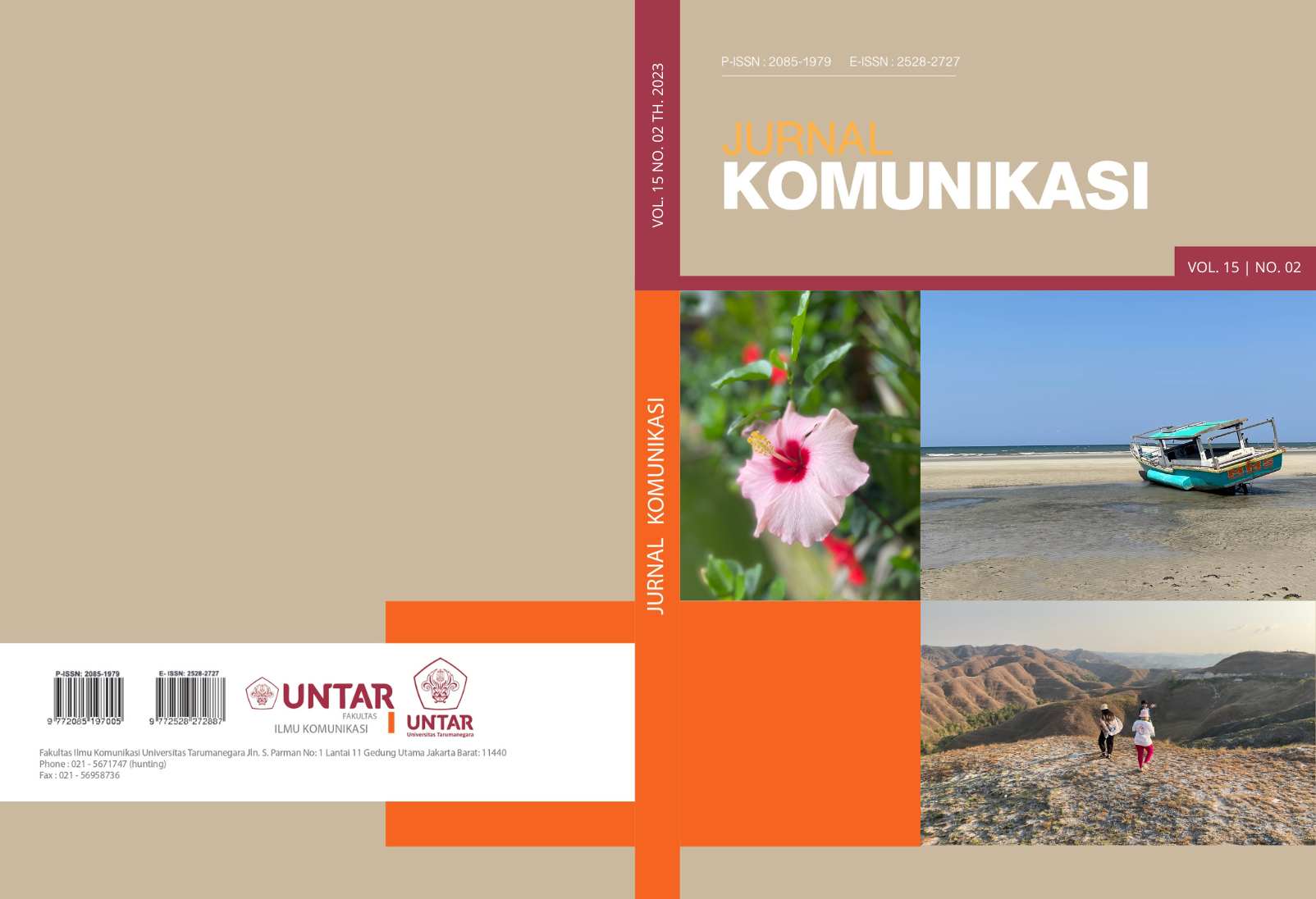Tiktok's Stitch Trends As A Feature Of Citizens' Negation In Communication On Social Media
Main Article Content
Abstract
One social media that is now very popular platforms is TikTok. Currenly active TikTok users in Indonesia are the second highest after the United States. TikTok servers not only as medium for marketing, branding, and self-existence, but also a medium full of negative content. One of prominent features of TikTok is widely used to respond to viral cases. However, this feature has also facilitated the occurrence of debates lead to conflicts among users. The purpose of this study is to get an overview of the TikTok stitch trend as a negation feature in citizen communication on social media. Netnography is the method used in this research. This research concludes that generally the accounts' self-presentation makes Stitch's image optimal in responding to viral cases. Generally, they negate (deny) viral TikTok videos in the hope that their negation is the most correct. Meanwhile, recipients of the messages created through stitches tend to respond by creating their own stitches, and/or providing comments as a form of feedback. Another finding of viral content, that are considered controversial by netizens, tend to produce hate speech and comments, mutual insults and bullying. Stitch is a communication channel for conveying ideas, opinions, criticism without filters with content that is less controllable and makes it more trending.
Article Details

This work is licensed under a Creative Commons Attribution-ShareAlike 4.0 International License.
This work is licensed under a Jurnal Komunikasi Creative Commons Attribution-ShareAlike 4.0 International License.References
Bizel, G., Amoroso, A., & Sharma, S. (2022). A Social Media Trend: How Does Tiktok Influence Adults? IEDSR Association, 7(17), 192–206. https://doi.org/10.46872/pj.468
CNN. (2020). Indonesia "Kisah Kejayaan TikTok di 2020". Retrieved from: https://www.cnnindonesia.com/teknologi/20201210145006-185-580569/kisah-kejayaan-tiktok-di-2020/2 pada 8 Februari 2023.
Data Indonesia. (2022). Pengguna Tiktok Indonesia Terbesar Kedua di Dunia. Retrieved from: https://dataindonesia.id/Digital/detail/pengguna-tiktok-indonesia-terbesar-kedua-di-dunia pada 9 Februari 2023.
Green, D., Polk, X. L., Arnold, J., Chester, C., & Matthews, J. (2022). The Rise Of TikTok: A Case Study Of The New Social Media Giant. Management and Economics Research Journal, 8(1), 1–6. https://doi.org/10.18639/merj.2022.9900063
Juditha, C. (2017). Hatespeech In Online Media: Jakarta On Election 2017. Jurnal Penelitian Komunikasi Dan Opini Publik, 21(2).
Juditha, C. (2018). Hoax Communication Interactivity in Social Media and Anticipation (Interaksi Komunikasi Hoax di Media Sosial serta Antisipasinya). Journal Pekommas, 3(1), 31. https://doi.org/10.30818/jpkm.2018.2030104
Juditha, C. (2019). Dukungan Sosial Warganet Di Twitter Terhadap Gaya Komunikasi Pasangan Calon Presiden Pada Debat Pemilu 2019. Jurnal Studi Komunikasi Dan Media, 23(1), 87. https://doi.org/10.31445/jskm.2019.1982
Juditha, C., Maryani, E., Abdullah, A., & Setiawati, R. (2022). Promotion of Prostitution Services on Social Media. Jurnal Komunikasi: Malaysian Journal of Communication, 38(2), 1–15. https://doi.org/10.17576/JKMJC-2022-3802-01
Khatami, M. I., & Kurnia, N. (2022). E-Demokrasi pada Perdebatan Publik di Twitter: Analisis Konten Polemik Pemecatan Pegawai Komisi Pemberantasan Korupsi (KPK). Jurnal Riset Komunikasi, 5(1), 51–69. https://doi.org/10.38194/jurkom.v5i1.449
Kozinet, R. V. (2010). Netnography: Doing Ethnographic Research Online. Sage Publications Ltd.
Levy, P. (2010). New Media Teori dan Aplikasi. Erlangga.
Librianty, Andina. (2020). Tiga Cara TikTok Mengatasi Konten Negatif. Retrieved from https://www.liputan6.com/tekno/read/4257237/tiga-cara-tiktok-mengatasi-konten-negatif.
Mahmoud, A. E. B., & Auter, P. J. (2009). The interactive nature of computer-mediated communication. American Communication Journal, 11(4), 1–36.
Mandhane, N., Ansari, S., Shaikh, T., & Deolekar, S. (2015). Positive feedback: a tool for quality education in field of medicine. International Journal of Research in Medical Sciences, 3(8), 1868–1873. https://doi.org/10.18203/2320-6012.ijrms20150293
Neuman L. W. (2003). Social Reseatch Methods: Qualitive and Quantitative Approanhes. Allyn & Bacon.
Oktarini, N. P. U., Dewi, N. P. K., Putra, M., & ... (2022). Analysis of the Positive and Negative Impacts of Using Tiktok For Generation Z During Pandemic. Journal of Digital …, 1(2). https://ejournal.catuspata.com/index.php/jdlp/article/view/167
Rahmansyah, Adia. (2023). Kominfo Belum Bisa Blokir Video Ngemis Online yang Viral di TikTok, Ini Alasannya. Retrieved from https://metro.suara.com/read/2023/01/19/200218/kominfo-belum-bisa-blokir-video-ngemis-online-yang-viral-di-tiktok-ini-alasannya.
Salman. (2017). Media Sosial Sebagai Ruang Publik. Kalbis Socio: Jurnal Komunikasi Dan Bisnis, 4(2), 124–131.
Santoso, E. (2011). Analisis Penggunaan Negasi Dalam Acara ”Debat Partai” Di Tvone.
Suara.com. (2023). Kronologi Perseteruan Nikita dan Bunda Corla Makin Panas dan Melibatkan Banyak Orang. Retrieved from https: //www.suara.com/ entertainment/2023/01/19/151151/5-kronologi-perseteruan-nikita-mirzani-dan-bunda-corla-makin-panas-dan-melibatkan-banyak-orang.
Suara.com. (2023). Menyoal Childfree Bahan Perdebatan Gita Savitri vs Netizen. Retrieved from https://yoursay.suara.com/kolom/2023/02/12/131050/menyoal-childfree-bahan-perdebatan-gita-savitri-vs-netizen.
Tarecha, R. I., Wahyudi, F., & Jannah, U. M. (2022). Penanganan Negasi dalam Analisa Sentimen Bahasa Indonesia. Jurnal Sistem Informasi Dan Informatika (JUSIFOR), 1(1), 51–58. https://doi.org/10.33379/jusifor.v1i1.1276
Usrina, N. (2021). Pengaruh Media Sosial Tiktok Terhadap Gaya Komunikasi Santri Taman Pendidikan Al-Qur’an Ar-Risalah. Journal of Chemical Information and Modeling, 53(9), 1689–1699.



